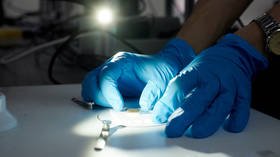Russian scientists invent a technology allowing to study viruses more efficiently

Now that the world is facing an invisible threat posed by the coronavirus, being able to manage what’s happening on a micro level is becoming even more important for human society.
One of the most recent achievements of Russian scientists, in this respect, has been a technology, which makes it possible to catch and move micro- and nanoparticles through laser beams, without any direct contact. This, in turn, could potentially allow for the manipulation of dangerous objects like viruses safely, while minimizing the risk of biological contamination.
The technology is the result of the research carried out by Russian scientists of the University of Tyumen (UTMN) and so far has had no analogues globally. It can be potentially used in a range of spheres. For instance, it can be used to remove viruses and bacteria from working surfaces, devices and instruments in labs, says the Head of the project, Natalia Ivanova of Photonics and Microfluidics Research Laboratory of the Institute of Environmental and Agricultural Biology (X-BIO) at UTMN.
Will this scientific achievement have any effect on ordinary peoples’ lives? Scientists say that most likely it will take place indirectly, through the creation of new technologies that will have fundamental importance for the production and creation of new components for electronics and optics, as well as in the field of microbiological research and biosafety issues.
According to Natalia Ivanova, her team has already come up with a pilot device which was planned to be publicly exhibited this spring, but was obviously postponed, due to the coronavirus outbreak.
“Currently, we are using particles of different materials such as polymers, ceramics, and glass that get placed in a sealed cell filled with a carrier fluid (water with some alcohol). Laser beams generate streams in this liquid which then carry the particles,” she explains.
Moving the light beam prompts the droplet to move, capturing all the particles in its trajectory. Due to the convective flow, the captured particles are kept inside the droplet and transferred to a specified place.
Scientists could manage such particles before, but it was expensive and only allowed for the manipulation of one or a few such objects, which is not often necessary and sometimes not possible, depending on material. Until recently, this method met the needs of the scientific community, but with the growing relevance of such research today, managing hundreds and even thousands of small objects has become increasingly more urgent.
The technology invented at UTMN can meet this demand with no significant time costs and allows “to manipulate such particles in big quantities, select their volume, transport them for further analysis and even pack them into sealed microcontainers”, in Ivanova’s words. What’s also important, the particles don’t get affected by such manipulations, which means that scientists can use this method while dealing with both non-living and living objects. This method is universal and affordable due to its simplicity.
Experimenting in space
The idea of this method was first coined by Ivanova’s research supervisor, Boris Bezuglyi, and then tested by Natalia for her dissertation project. The subsequent work on applying this method while dealing with hard particles started in 2014, within a joint project with Dr. Victor Starov from Loughborough University supported by the Russian Foundation for Basic Research (RFBR) and the Royal Society of London for Improving Natural Knowledge.
As Natalia recalls, the goal of the project at the time was to develop a non-contact method for cleaning hard surfaces during experiments on board the International Space Station. Such surfaces, used for micro experiments, must be 100% clean to ensure correct results.
“Not every surface can be cleaned by a tissue or with water with cleaning liquids. So, it’s clear that nano- and even microparticles can’t be addressed with our traditional methods,” she notes.
Surfaces can be made of various different materials and have different functions. The scientists at UTMN focus on surfaces that can be used for certain research experiments, like microboiling (when micro amounts of liquids get boiled). To ensure the accuracy of the experiment, a researcher must ensure that there are no foreign particles on the given surface whatsoever.
This becomes even more difficult when one takes such tests into space. “There, nanoparticles not only affect the fairness of an experiment, but also the security of the crew and the craft itself. Plus, there are certain weight limits, which means that one cannot simply carry more experiment surfaces into space - thus, it’s necessary to have an optimal way to clean it and use it multiple times,” according to Natalia.
Dealing with biological threats
After the completion of the space project, Russian scientists continued to work on the technology. This way, they came up with a compact automated device with multiple lasers, which can be managed remotely from a computer.
“This allows for a range of manipulations with micro objects at the same time and work with micro objects without direct access, which clearly has potential to be used for working with pathogenic microorganisms or with some new, not-yet-studied biological objects that may pose a threat,” Natalia Ivanova explains. “That’s why our next step will be to partner with microbiologists to test our device in their work.”
The Photonics and Microfluidics Research Laboratory is part of the Institute of Environmental and Agricultural Biology (X-BIO) at the University of Tyumen (Russia). The strategic objective of X-BIO Institute is to address its research to urgent international challenges such as hunger, environmental protection, climate change and antimicrobial resistance. The X-BIO Institute is home to research groups dedicated to microfluidics, chemistry of natural compounds, crop production, soil biology, microbiology and antimicrobial peptides, entomology, acarology, plant pathology, and plant protection.












